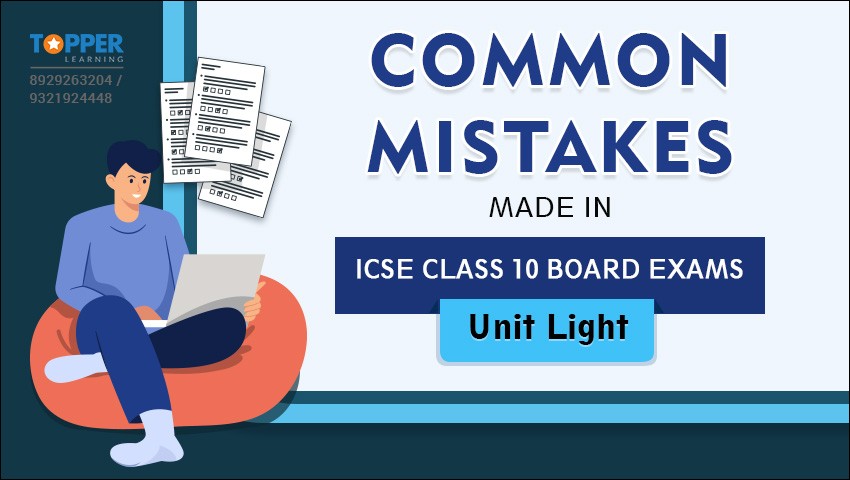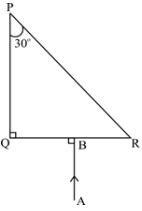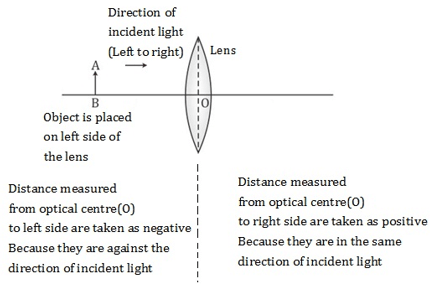Common Mistakes Made in ICSE Class 10 Board Exams - Unit Light

This blog post highlights common mistakes students make in one of the scoring units Light in their ICSE physics papers. CISCE's assessment of student performance serves as the foundation for these analyses.
By Topperlearning Expert 23rd Feb, 2024 | 11:09 am
ShareLight is one of the essential units for the ICSE 10 board exam, which consists of three chapters: refraction of light at plane surfaces, refraction through lens, and spectrum. Some students need help with these chapters while preparing for their ICSE class 10th board exam, and some might skip this unit altogether. However, this can be a grave mistake since this unit covers various crucial topics related to refraction, dispersion, and scattering and some of their applications. Furthermore, many students often make some common mistakes while answering the questions from this chapter in their board exams. Through this blog, we aim to highlight these common mistakes and provide insights to students so that they can maximise their board examinations.
Mistakes made by Students while answering questions related to Refraction and the Laws of Refraction
For example, while answering the questions given below, students made some common errors that must be avoided:
Q. A diver in the water looks obliquely at an object AB in the air.
(i) Does the object appear taller, shorter, or of the same size to the diver?
(ii) Show the path of two rays AC & AD starting from the tip of the object as it travels towards the diver in water and hence obtain the image of the object.
Students made some mistakes while answering these questions in their board exams.
- For question (i), most students were able to answer this question correctly. Still, a few needed to improve while answering this question, as they needed help establishing the relation between the size image and the change in the medium.
- Some considered the light ray passing from a denser medium to a rarer medium, whereas some wrote that the object appears shorter, while others wrote that it is the same size.
- While answering question (ii), students made several mistakes, such as:
- Not marking arrows on rays.
- Showing partial reflection with refraction.
- It does not show the extension of rays and dotted images
- Showing incorrect image position and incorrect refraction.
Mistakes made by Students while answering questions from the Topic Refraction of Light through a Prism.
For example, while answering the questions given below, students made some common errors that must be avoided:
Q. Complete the path of the ray AB through the glass prism in PQR till it emerges out of the prism. Given the critical angle of the glass as 42° 
Here are some common mistakes students make while answering these questions in their board exams.
- Didn’t consider the critical angle of the glass (42°) when determining the ray's path through the prism.
- Incorrectly depicting the refraction of the ray at the surfaces of the prism, especially near the critical angle.
- Failing to show the correct incidence and refraction angles at each prism surface.
- Not ensuring that the emergent ray exits the prism in the correct direction after refraction.
- Drawing the emergent ray at an incorrect angle or position relative to the prism.
- These errors can lead to inaccuracies in the representation of the ray's path through the prism and may result in scoring deductions in the exam.
Mistakes made by Students while solving problems-based questions from the topic Refraction of light through the lens.
For example, while answering the questions given below, students made some common errors that must be avoided:
A lens of focal length 20 cm forms an inverted image at a distance of 60 cm from the lens.
(i) Identify the lens.
(ii) How far is the lens present in front of the object?
(iii) Calculate the magnification of the image.
Students made some common mistakes while answering this question in their board exams.
- Most of the students could identify the lens type correctly.
- Some made mistakes while doing a substitution.
- Some used incorrect sign conventions for question (i), whereas some students should have paid more attention to the sign conventions while calculating the lens magnification.

For example, we must use a positive sign if the image is upright, whereas a negative sign denotes the inverted image. - A few students incorrectly wrote the unit for magnification, a unitless quantity.
Tips to keep in mind.
Here are some tips for students that will help them avoid such mistakes and score better in this chapter.
- Practice drawing ray diagrams regularly with all the labeling to increase proficiency and manage your time correctly.
- Learn how to apply the laws of reflection for each surface when a ray of light travels from one medium to another instead of rot memorising the ray diagram.
- Remember the refractive index of mediums such as air, water, etc., and represent them accordingly while answering problem- or diagram-based questions.
- Always draw arrows before and after refraction to indicate the direction of light.
- Remember to represent virtual images with dotted lines and show apparent intersections clearly.
- Practice solving numerical problems related to the lens formula to strengthen problem-solving skills in optics.
Conclusion:
We hope you enjoyed reading this blog and learned something new today. Avoid these common mistakes while writing the paper. Also, check out our free resources and learning materials. At Topperlearning, we bring you unique e-learning experiences, providing quality resources to students nationwide. The study materials are available for CBSE, ICSE and Maharashtra Board alongside the resources for competitive exams like JEE and NEET.
More from Education
Important Resources
- Education Franchisee opportunity
- NCERT Solution
- CBSE Class 9 Mathematics
- NCERT Solutions for class 10 Science
- Sample Papers
- CBSE Class 9 Science
- NCERT Solutions for class 10 Maths
- Revision Notes
- CBSE Class 10 Hindi
- CBSE Class 10 English
- CBSE Class 10 English
- CBSE Class 10 Social Studies
- CBSE Class 10 Science
- CBSE Class 10 Mathematics
- Career In Science After 10
- Career In Commerce After 10
- Career In Humanities/Arts After 10
- NCERT Solutions for Class 10
- NCERT Solutions for Class 11
- Business Studies Class 12 CBSE project





